Our Oceans Currents --- The big blue migration of waters.
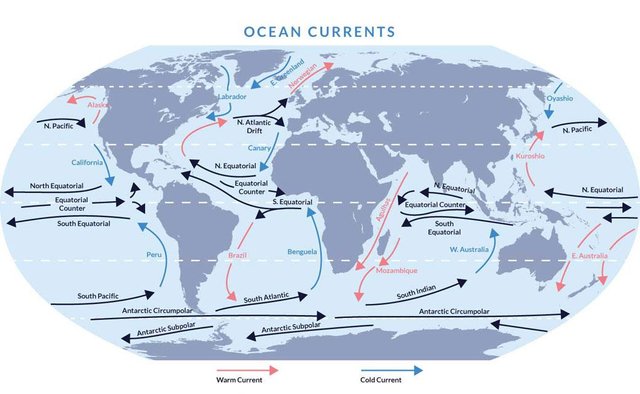
Happy weekend steemit, It's Annie here, and I've decided to have a go at a topic that's quite fascinating to me. You know, how something appears to be what it is to the untrained eyes, but a closer look would suggest there's more to it.
I bet at some point, we might have heard of how water in a river/ stream flows. It's pretty obvious since we can see its flow and the direction it's going. However, the ocean as we know it, is pretty much like a trough of water. apart from the boisterous waves thrown around shorelines, the middle tends to be blue and still when there is no storm. Hence, There's no telling where it's flowing to.
Let's make an imaginary character, and call him Bob. Now, suppose Bob missed the last ship and got stranded on a desert island, and is unable to get off it. He writes down a distress message on a piece of paper, puts it in a plastic bottle and throws it into the sea. Is there a way to ascertain where the bottle would go?
Actually, all hope isn't lost. Nature has created a way to save our friend and that's going to happen through a phenomenon we call Ocean Currents.
Ever read how Thor Heyerdahl of Norway demonstrated the existence of ocean current by floating on a wooden raft from South Africa to Polynesia in 1947? Interesting fact, I tell you. He did it without the use of a motor or an oar.

Ocean Currents:
Now, before you go all wondering and stuff, there is a whole world of difference between ocean current and electric current. while the both of them bear the term "current", They have a congruence: current denotes movement or flow/push.
Our Earth is made up of 70% water with the Ocean being the greatest reservoir of it. The statement "Water is life", is true in many levels. Water sustains and regulates the body, transports nutrients in plants and animals, etc etc... In fact, one really cool thing we know about water is that; it takes on the shape of its container, and any trench it is being put in.
Looking at it from a distance, (and neglecting the occasional waves it produces.) the ocean looks pretty calm. At the middle, what we see is the ol' still-deep-blue, but unknown to the natural eyes, the ocean is actually heading somewhere. It contains stream-like movements of water in a particular direction called Ocean Current - We could easily imagine it is as water migrating on its own without needing help from you and I.
As ocean currents move, they distribute heat and nutrients around the globe.
Ocean current is influenced by a number of factors such as weather, The Earth's rotation and the position of the continents. I would talk a bit more about this in a minute, I hope.
Now, back to our current. Earth is made up of four oceans. which we know to be The Arctic. The Atlantic, The Indian and The Pacific. These huge water reserves have two ocean currents in common. The first one is called Surface current, which is just the stream-like movement of water at the surface of the ocean. It is caused by strong winds over the ocean and uneven heating. Secondly, we have the Deep current, which occurs deep down beneath the surface of the ocean. Briefly, let's learn a few things about these currents.

Surface Currents.
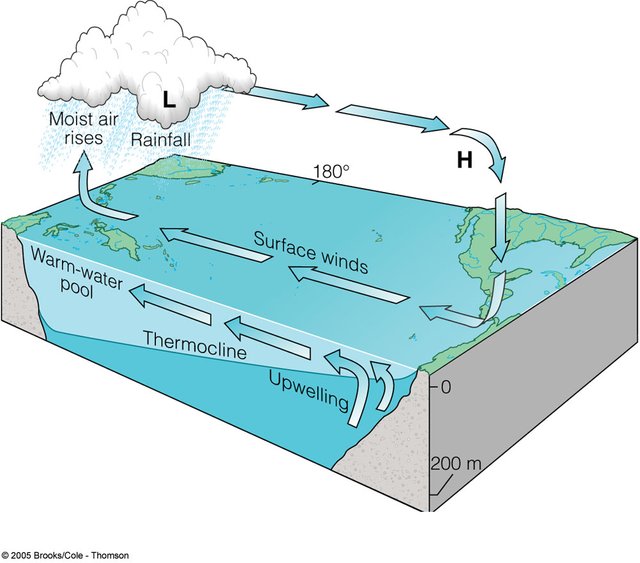
Here's one way to illustrate the existence of surface current: Back when I was younger, mom would make hot tea for breakfast, and I'd prefer allowing it to sit a couple of minutes before drinking because I found it quite hot. Sometimes, I would pour it into a wider plate and blow on it with my breath. If you've tried this before, then you'd have noticed that ripples are formed on the surface as you blow. That's exactly how surface winds creates surface current.
Just because it is called surface current doesn't indicate it is meant to be on the surface only. Your breath is dwarfed in comparison to a gust of strong wind on the ocean surface. Hence, surface current can reach up to a depth of 100 - 200 metres deep and span several kilometres in length. Surface currents transports 20 times more water than all the rivers in the world.
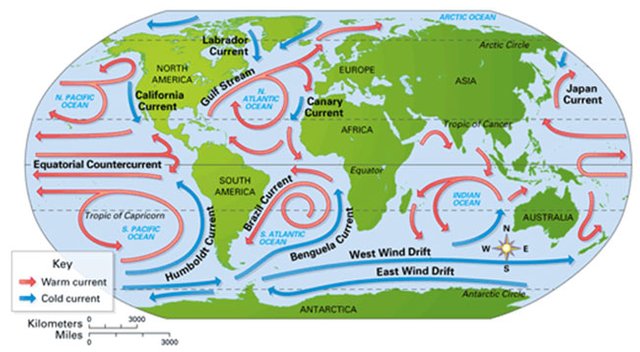
From the image above, the position and direction of the Golf stream, which is one of the longest surface currents is shown. The Golf stream is known to transport 25 times more water than all the rivers in the world.
The Earth's rotation also plays a role on ocean currents as well. It causes surface currents in the northern hemisphere. In the clockwise direction, and curls it anti clockwise in the southern hemisphere.
Near the equator, its quite the opposite and different as water is blown from the east towards the west. The poles witness it from west to east.

Deep Currents.
In classical physics, we understand how one tends to feel lighter as they travel upwards or increase in altitude towards space, and also how they'd feel a bit heavy, clumsy and uneasy when they descend the depths. Like mixing dense chocolates syrups to water, dense liquids sink to the bottom.
Unlike surface currents, which are governed by tides (interactions with the sun and wind), Deep water currents make up 90% of the ocean currents, and they occur as a result of the interaction between a number of factors including Temperature, water density and salinity. Just as cold water is known to be a lot more denser than warm water, it sinks to the bottom and the warm water rises to the surface. The constant motion of colder/ heavier water sinking to the bottom to replace less salty warm water rising to the surface creates the Deep currents.
These Deep current processes occur simultaneously and are given the terms;
- Down-welling
- Up-welling.
Down-welling:
Down-welling is the movement of heavier and denser water from the surface to deep underneath. this allow for animal to be able to live deep down underneath, as earlier stated, water underneath contains a lot of minerals, so much that with increase in depth, salinity increases.One of the ways water down-wells is through evaporation. As surface water is heated, it evaporates into the atmosphere, leaving behind solids. If these solids become frozen, the sink to the surface hence increasing the salinity. Hence, giving rise to a corresponding up-well or rise.
Up-welling:
Up-welling is given rise to as a result of wind patterns on surface water, and just how much nature hates a vacuum. When wind blow from land surface towards oceans it creates a surface current and tends to push the water inwards towards the sea. This creates movement of water and causes the more dense water underneath to rise up simultaneously to fill up next place. Hence, beginning an Up-welling motion, which is a type of deep currents.
Importance of ocean currents:
Perhaps one of the most interesting facts about ocean currents is how we are all closely connected. Through the processes of down-welling and up-welling, water carrying minerals and nutrients from deep down the ocean gets to coral reefs, plankton and other life forms at the base of the food chain. Also, down-welling traps oxygen atoms and transport them to the deep where there's little or no oxygen.
Ocean currents studies are necessary for understanding and predicting our climate, seeing that the tides are controlled by the gravity of our solar system neighbours.
Land and sea breezes during the day and at night respectively helps keeps the earth at a normal habitable temperature
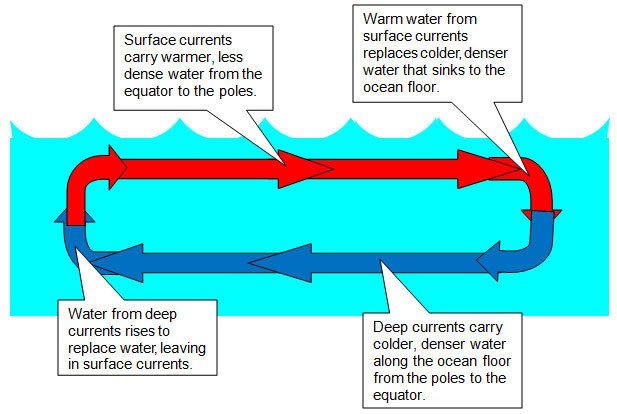
The whole thing works just as a factory conveyor belt would. One end rises, and the other dips! Here's a quick recap!
Surface current pushes warmer and less dense water from other oceans regions to polar regions. The gulf stream moves warm water north eastward towards Great Britain. that would explain why there are no polar bears there.
Warm water reaches and replaces the denser water that sinks to the floor of the ocean.
Deep currents in turn move in the opposite direction to warm water towards the equator and rises to replace water leaving due to surface currents).
Basically, from what we have seen so far, the oceans in our planets have a direction they're constantly running towards. Hence, there is a huge chance that our imaginary friend, Bob could get help and find his way home .
Thank you for reading.
References
Wiki, Ocean currents, science daily., Briticanna

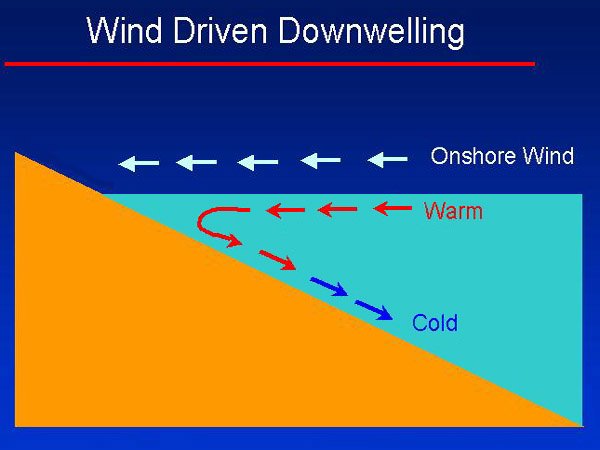
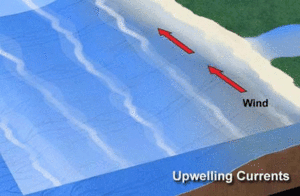
This is a test comment, notify @kryzsec on discord if there are any errors please.
Being A SteemStem Member
As a follower of @followforupvotes this post has been randomly selected and upvoted! Enjoy your upvote and have a great day!